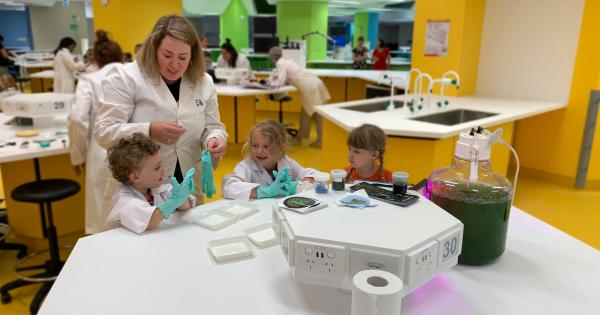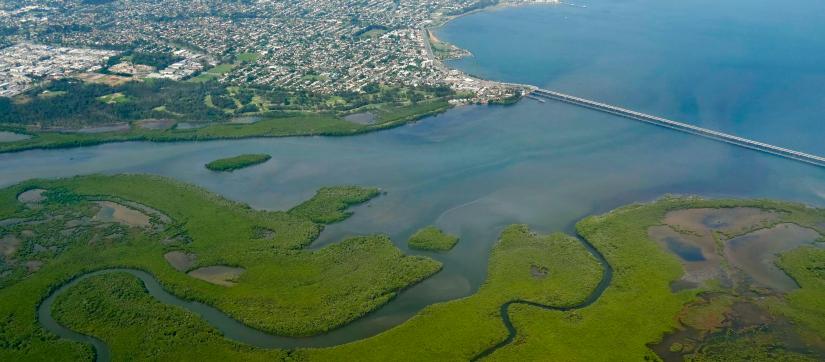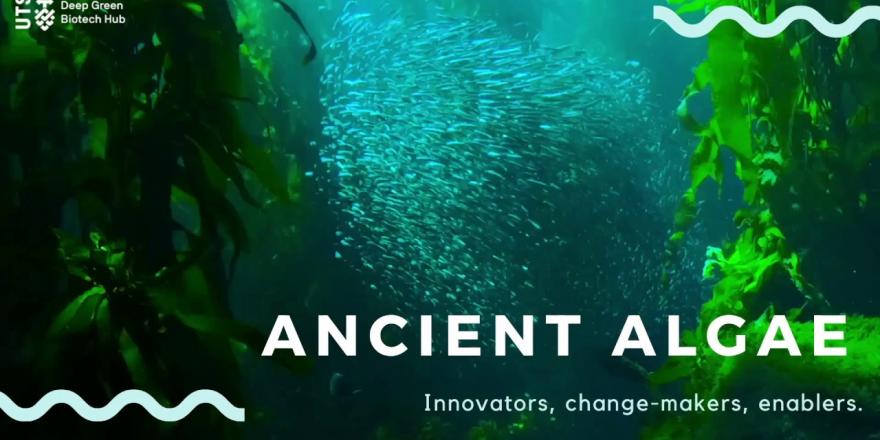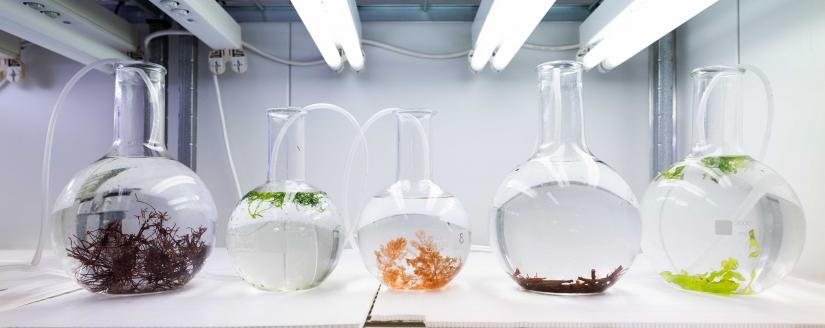We've curated an online, syllabus-mapped sustainability resource for Stage 4 - 5 High School Science Students that develops students' understanding of the biotechnological applications of science to address climate change and sustainable development

Amazing Algae Activities
Amazing algae: innovating with biology for a sustainable future
This education program has been curated in consultation with world-leading researchers and educators in algae biotechnology from the University of Technology Sydney. Using current findings from real-world research from Australian universities, this program aims to engage science students with the green technologies of tomorrow.
Concept 1: Algae in our lives

This section explores the role that algae played in the Earth's history, and the vital role it plays in ecosystems and Earth systems today. It covers key concepts in biology, evolution, ecology and sustainability.
Learn
Intro to algae
What exactly is algae? Algae is the name given to a diverse group of photosynthetic organisms that live primarily in aquatic environments, where they form the foundation of the food-chain. You might have come across algae already at the beach - seaweed is a kind of algae, and so is the slippery brown/green 'slime' that grows on rockpools. You may have actually eaten algae products today - it's found in sushi and sometimes in yoghurt, plant-milks and icecream. Algae can be found in almost every environment on Earth, and together they produce over 50% of the world's oxygen - even if you've never heard of algae before - it's the reason you and I are alive today.
📼 Watch this video to learn more about these amazing organisms.

This is the amazing story of an ancient and little known organism that has the potential to transform the way we live, produce and consume.
Algae are the earliest ancestors of all plants, first appearing around 2.5 billion years ago.
Since then they have diversified to somewhere between 30 000 to 1 million different species, coming in all different shapes and sizes.
Microalgae are tiny cells, invisible to the naked eye and smaller than the diameter of a human hair.
Macroalgae are more complex and made of many cells - with some species, like kelp, reaching lengths of nearly 60m.
Anywhere there is water, algae can grow. They are abundant in the oceans and in rivers, lakes and streams.
Most algae are photosynthetic, which means they use the sun’s energy to turn water and carbon dioxide in the air into sugar for energy.
Algae are the forests of the ocean, and collectively produce up to 50% of the Earth’s oxygen - you can thank algae for every second breath you take.
Just like plants, algae convert the sugars from photosynthesis into 3 important products to build their cells - protein, carbohydrates, and oils. .
But they can do this much faster, with some species able to double in size in just 24 hours.
Furthermore, algae only needs a fraction of the land area and water to grow the same amount of protein in a steak or a piece of tofu.
This means algae doesn’t compete for land or precious resources.
Algae are efficient and sustainable little biofactories, and scientists and business are exploring algae alternatives for a variety of industries - including food, pharmaceuticals and cosmetics, animal feed for livestock and aquaculture, pigments, fertiliser, bioplastic for packaging, and materials for clothing and footwear.
Algae can even utilise waste streams to grow - including excess nutrients from wastewater and captured carbon dioxide from industry.
In this way, algae can create products and processes that are carbon neutral, climate friendly, sustainable and better for the health of communities and the environment.
A greener, brighter future is possible with algae.
To learn more visit us at the Deep Green Biotech Hub.
Algae in our global past
Algae have survived on this planet for the last 2.5 billion years, where they played a vital role in creating the conditions to support the evolution of life on Earth.
📼 Watch this video to learn about 3 billion years of evolution in 3 minutes.

Algae are arguably some of the most successful forms of life on the planet.
And though you might not know it, you and I and everyone we know is alive today because of their success.
Over a period of several million years, the changes brought about on Earth by these organisms created the conditions for life as we know it to evolve.
If you hopped in a time-machine and travelled back two and a half billion years, you wouldn’t be able to breathe - There was almost no oxygen.
Life had first appeared on Earth a million years earlier, in the form of simple organisms like bacteria. This early life thrived in an atmosphere thick with volcanic gases like nitrogen, methane, carbon dioxide and sulphur.
In the shallow seas of this hostile world, an organism called cyanobacteria evolved a remarkable way of acquiring energy, known as photosynthesis
In doing so, they seeded the atmosphere with oxygen for the first time.
And over the next billion years, cyanobacteria produced enough oxygen to change the world forevermore.
Initially, this caused a mass extinction, as the oxygen algae created was poisonous to much of the existing bacterial life on Earth. However, it set in motion an astonishing, life-giving possibility...
By 600 million years ago, the abundance of oxygen created by algae caused the ozone layer to spontaneously form around the Earth, which offered protection from the sun’s most harmful UV radiation.
This incredible biochemical protection allowed early life to emerge from the deep oceans and the evolution of higher plants and forests, which in turn, increased the amount of oxygen in the atmosphere.
With an abundance of plants for food, and oxygen to create energy, organisms grew to be larger, and more mobile.
Without algae, life on this planet may never have evolved beyond a single cell.
Algae’s earliest ancestors have now evolved to over 70 000 known species, which drive life in the oceans, and in freshwater lakes and rivers.
Algae play an important role in global oxygen production and carbon storage in the oceans, and have adapted to live in deserts, glaciers and soils and even with other organisms as coral and lichen.
Algae played an important role in our past, and will play an important role in our future too. Today, scientists are turning to these innovative change-makers to help solve some of the most pressing modern sustainability problems of our time.
To learn more visit the Deep Green Biotech Hub.
Dive Deeper
READ THIS article about a recent discovery of a 1 billion year old multicellular green algae fossil
-
Recall that algae can be both single-celled or made of many cells (multicellular) and that the rapid spread of multi-celled forms of algae, like the green seaweed described in this article, was responsible for the formation of Earth’s ozone layer.
📼 WATCH THIS TED TALK BY DESIGNER SUZANNE LEE ABOUT 'BIOFABRICATION'’ (0.36 - 3:40).
- Think about the ways in which this new ‘industrial revolution’ with biological materials differs from the industrial revolution of the past. Consider what ethical considerations might arise from engineering and designing with biological organisms in this way, and why they are important in science. Discuss these considerations as a class.
Check your understanding
-
Test your understanding of the key concepts in the algae videos with this quiz (opens external Kahoot link).
Discuss
As a class, or in small groups, discuss the below topics:
- Think about the algae journey, starting from 3 billion years ago to where you are today, as well as algae’s current role in ecosystems. List 3 ways in which your life is directly tied to the existence of algae? Try to imagine the Earth without it, what would it be like?
- What does it mean for something (a product, a resource or a service) to be sustainable? List 3 requirements for sustainability. Can you think of other examples of sustainable resources?
-
Australia is a signatory to an international agreement known as the Nagoya Protocol. The agreement provides a legal framework to ensure that benefits from the discovery and use of native plants and animals (genetic resources) are shared with Indigenous people who have cultural knowledge related to those plants and animals. Why might this agreement be important if an economically or scientifically valuable algae species was discovered on Aboriginal land?
Engage
In this next section, apply your scientific skills to your newfound algae knowledge. These activities explore identification, balancing chemical equations and understanding energy transformations. In science, biology, chemistry and physics are intertwined.
Activity 1 Resource: "Identifying Algae with a Dichotomous Key" slideshow (PowerPoint download).
Activity 2 Resource: "Exploring Photosynthesis" PowerPoint (PowerPoint download).
Activity 1, 2, & 3 Worksheet: "Amazing Algae Activity Sheet" (Student Worksheet Interactive PDF download)
Innovate
To translate science from the laboratory into the real-world, creativity and communication are vital. Flex your creative thinking skills with the below pitching activity:
Imagine you work as a science communicator, and you have been given a brief to shift public perceptions about algae, from nuisance environmental problem to amazing sustainable resource. You want people to realise the potential of algae and start creating with it.
Can you write/create a short pitch to businesses, government and the public?
📼 Watch one of our Green Light teams pitch their algae idea. Video begins at start of UCarryIt pitch (32 min 49 seconds - 36 min 42 seconds).
- Think about what makes a "pitch" different from a regular speech / presentation.
- After watching this, what do you think is the purpose of the pitch?
- How did the team define the problem, and how their product / business was going to solve it?
- Do you think their idea solved the identified problem?
Design thinking
It's time to think innovatively about algae. To complete this activity, work through the key steps in the Design Thinking process:
- Define the problem - Read this article about algal blooms and discuss what you are trying to change and why?
- Ideate - Now read this article about algae's potential as an amazing resource. Brainstorm as many ideas as you can about how you can shift public perceptions of algae (don’t worry if your ideas seem silly or ambitious - anything is possible).
- Try it out - Reflect on your ideas. Which one is the most effective.? Will it work for your target audience?
-
Iterate - Keep going, keep testing and refining your idea until you choose the right fit. Ask your classmates, survey different classes / teachers, and develop from the feedback.
-
Finally - Present your ideas to the class, or make a marketing poster, audio or video.
Concept 2: Algae in our future

In this section, We'll explore the cutting-edge research, technologies and emerging industries that are harnessing algae's potential as a renewable, sustainable resource for a greener future.
Learn
Algae Futures
From producing alternative materials that reduce our reliance on fossil fuels to solving waste and feeding a growing population, algae biotechnology offers a way for scientists and businesses to innovate for a sustainable society
📼 Watch this video to learn about the ways in which algae biotechnology can offer greener alternatives to address a variety of global sustainability issues.

Nature has long been a source of inspiration for innovation,
And in the face of multiple, interconnected sustainability problems, scientists and businesses are turning to algae to innovate for a greener future.
Many of our modern processes for producing materials are unsustainable and put pressure on environmental health.
At current rates of consumption, we are exhausting one year’s worth of resources in just six months, or roughly double what the Earth can sustain.
By 2050, unless we change the way we do things, our 9 billion-strong population will require the equivalent of 3 Earth’s worth of resources.
Algae have the potential to help reduce demand on the world’s resources.
Like efficient solar-powered biofactories – algae convert abundant sunlight, carbon dioxide, water and nutrients into useful compounds.
These compounds in algae cells can be harnessed to create renewable and sustainable alternative materials.
Algae can be a substitute for the petrochemicals that are used in a multitude of products, including:
Plastics, synthetic fabrics like nylon and polyester, shoes, surfboards, paints, pigments in our food and even beauty products!
Petrochemicals are compounds made from fossil fuels which need to be extracted and processed, emitting carbon dioxide in the process.
Algae, on the other hand, can be grown using endlessly renewable sunlight - absorbing carbon dioxide in the process.
Using more climate-friendly algae alternatives offers a way to reduce our reliance on fossil fuels.
Algae has a tiny water and land footprint compared to other protein sources, and can be grown anywhere there is abundant sunlight – even in deserts and on rooftops.
Algae is nutrient rich, and full of protein and healthy fats like Omega 3.
This means algae can offer a sustainable alternative to protein sources, fish oil supplements and feed for livestock and aquaculture operations.
In doing so, algae-based foods can reduce the pressures of overfishing, deforestation, land degradation and pollution.
Not only can algae offer biodegradable alternatives to plastics and packaging, they also have the potential to clean up our air and waterways.
Algae can absorb the excess nutrients in wastewater, and carbon emissions from industry or breweries.
It can then be harvested and turned into products, transforming waste into a resource.
Algae will enable multiple industries to transition to more sustainable business models.
Algae solutions form part of an emerging bio-economy worth billions of dollars, creating green jobs and contributing to future prosperity, without putting pressure on the Earth’s precious resources
To learn more about algae futures, visit us at the Deep Green Biotech Hub.
Dive Deeper
Explore some of the real-world sustainability solutions using algae biotechnology.
Read ABOUT FUTURE FEED - CSIRO's animal feed seaweed supplement that reduces livestock methane emissions
- As a class, do some research to find out what proportion livestock methane emissions contribute to Australia's total annual carbon emissions. What other, wider environmental benefits might there be from using seaweed in cattle feed and fish aquaculture feed?
📼 WATCH THIS ABC NEWS FEATURE ABOUT A SYDNEY BREWERY USING ALGAE TO OFFSET THEIR CARBON EMISSIONS
- Consider that growing algae can create both services and products: carbon absorption and oxygen production as a service, and renewable resources as products. Can you think of other examples of sustainability innovations that turn waste products into valuable resources?
Innovate
Time to imagine your greener future.
Given what you have learned about algae, in groups or as a class, think about and design a product that could be made using algae to make an existing product or process more sustainable.
Design thinking
It's time to think innovatively about algae. To complete this activity, work through the key steps in the Design Thinking process:
- Define the problem - what are you trying to fix or change and why? Why is the current product unsustainable?
- Ideate - Individually, in groups or as a class, brainstorm as many ideas as you can about how algae might be able to solve the problem (don’t worry if they seem silly - go for quantity of ideas).
- Try it out - Reflect on your ideas, do they help you solve the problem?
- Iterate - Is your idea actually technically and economically feasible? Ask your classmates, survey different classes / teachers, and develop from the feedback.
-
Finally - Present your idea/innovation to the class:
-
Describe the original product/process you chose to replace with algae and outline why it is unsustainable.
-
Describe your process of elimination, how did you come to choose your final idea?
-
Outline how your idea will solve the sustainability issues raised.
-
Give a brief outline of how you are going to get your idea off the ground to become widespread in society.
